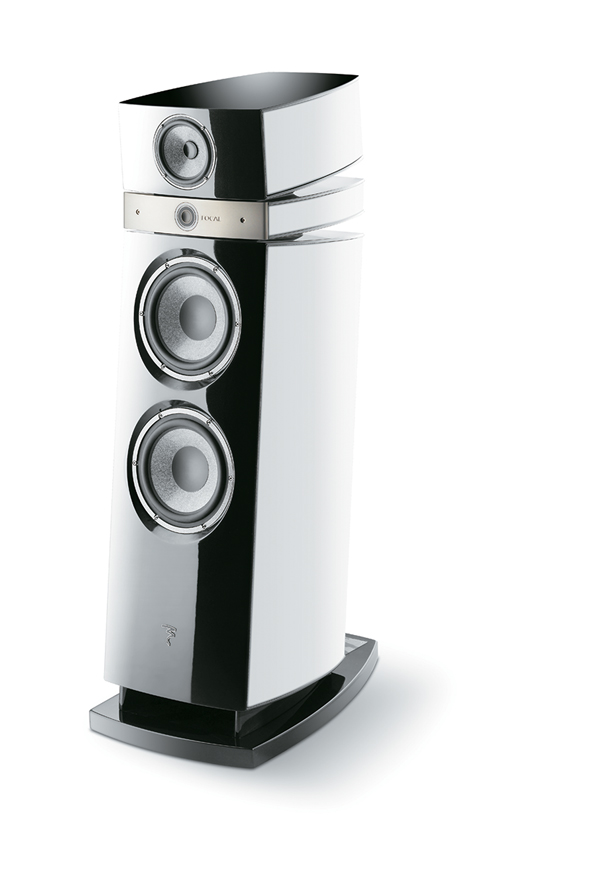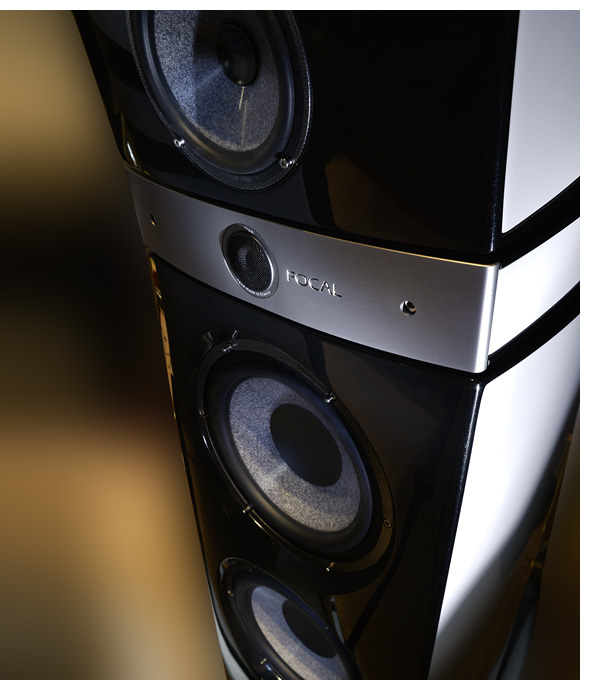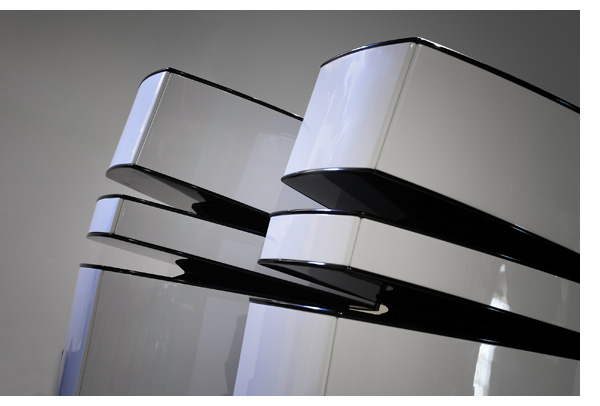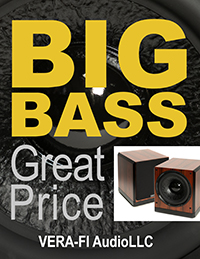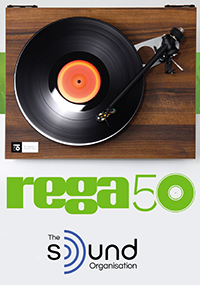The second I queue up the Afghan Whigs’ album Gentlemen, I know these speakers are special. The reproduced soundstage on this record is massive, with the wind in the background of the opening track, “If I Were Going,” sounding much more expansive than I’ve ever heard it, save perhaps what I experienced at the Boulder factory last year via the Grande Utopia EM speakers and the prodigious Boulder 3050 monoblocks—the most compelling audio system I’ve yet experienced.
Yet slumming it back at my place, with the Pass Labs Xs 300 monoblocks and the Maestro Utopias, a bargain at $60,000 per pair, I’m getting in the ballpark. As soon as the drumbeats hit hard on the title track, we are indeed getting serious slam. These speakers move major air without fatigue, distortion or coloration. They are marvelous. Sure, the Grandes are even more amazing, but you need the room to let them breathe and the rest of the system has to be equally astounding to really allow the speakers to reach their full potential.
I won’t apologize for telling you to get a pair of $60k speakers, and I don’t want to hear all the tired arguments about how you can build a pair of these yourself for a lot less money. You can’t. Sure you could buy a nicely appointed 5-series BMW for the price of the Maestro Utopias, but the hi-fi system inside is rubbish. The arguments about diminishing returns are also moot—you won’t get this level of musical involvement for $10k, $20k or even $30k. You’ll have to pay if you want to play, but the good news is that the Maestros will reward you in a way that few speakers can.
What makes the Maestros so compelling is that you can build an amazing system around them for little more than the cost of a pair of Grande Utopias. And while a $150k-to-$250k stereo system is somewhat obsessive, the $500k-plus that it’s going to take to make the Grande’s sing is a completely different realm, hence these speakers will appeal to a completely different buyer. So, if you’ve drooled over the sound of the Focal Grande Utopias, and either don’t quite have the budget or the room to take advantage of them (or maybe you’re just a bit more frugal), the Maestros do not disappoint.
Spinning AC/DC’s “Rock and Roll Ain’t Noise Pollution,” I’m again reminded of how well the Maestros can create the sheer sound pressure of a live rock concert without compression or fatigue. Even at brain-damage levels, the meters on the Xs 300s are barely moving from the center position, indicating that they are working in full class-A mode throughout my listening session.
And installing the Maestros is a breeze. Though just more than 250 pounds each, the Maestros are easy to remove from their shipping cartons. Thanks to the wheels on the cartons, you can move them to your listening area by yourself, though you will probably need a friend to help you to remove the speakers, which also have wheels, and get them into a rough position.
Focal’s manual is thorough in describing setup and, depending on your room, you should be able to get the Maestros fairly close to fine-tuned while still on their wheels. Once satisfied that you’ve optimized the bass response for smoothness and weight, remove the wheels and experiment with the spikes to adjust the speaker rake angle to perfection.
The jumpers at the speaker’s base provide ultra-fine-tuning, allowing a modest adjustment of bass, midrange and treble energy. Fortunately in my listening room, I do not have to deviate from the factory settings, and trying them does show their effectiveness. The additional bass boost works well with the Pass First Watt amplifier and an 845-based SET amplifier, both of which are a little shy in the low-frequency department.
Sensitivity Makes All the Difference
Thanks to a 93-dB sensitivity rating, the Maestros work well with a 60-watt-per-channel tube amplifier, and we achieve amazing synergy with the 60-watt PrimaLuna DiaLogue monoblocks in for review (you can read the review here), but this gives the Maestros a different character. They lack some of the pulverizing dynamics that they do with a big solid-state amplifier, yet even hardcore hip-hop tracks, like Wu-Tang Clan’s “Protect Your Neck,” still hit with plenty of clarity at all but club levels.
The Maestros, like the Stella and Diablo Utopias that we’ve spent plenty of time with, are equally tube friendly, so don’t shy away from these speakers if you’re a tube user. The Audio Research REF 250 monoblocks, Octave’s Jubilee monoblocks and even the PrimaLuna ProLogue Premium monoblocks all work brilliantly with these speakers, thanks to their exceedingly tube-friendly crossover network.
As phenomenal as the Maestros are with big solid-state amps, I must confess my own personal bias and admit how smitten I am with these speakers when pairing them with vacuum-tube amplification. For those just tuning in to TONEAudio, I prefer my personal system to be a few molecules on the warm, romantic side of neutral, yet not lacking in cloudiness, detail or resolution—a tall order indeed.
Tubey Goodness
Yet this is exactly what the Maestros provide when paired with a great tube amplifier. The beryllium tweeter is as fast and transparent as any electrostatic speaker I’ve owned (and I’ve owned almost all of ’em), and a little bit of tube warmth makes them feel like a pair of giant Sound Labs ESLs but with major dynamics and punch. Put a fork in me, I’m done!
Sonny Rollins’ classic album Tenor Madness just leaps out of the speakers, with the Maestros painting a vivid picture of this quartet in my listening room. Bass is solidly anchored, with everything lovers of pace and timing will ever need to be ecstatic. No matter how complicated the program material, the Maestros never fail to keep up with the music, regardless of listening level.
The piano is reproduced with all the necessary timbre and attack to sound great, but what pushes it over the top is the scale. In a good-sized room with plenty of amplifier power (solid state or tubes), the Maestros reproduce scale in a way few other speakers can. This is what separates great speakers from truly exceptional ones for this reviewer, and you can put the Maestros solidly in that rare latter category.
These speakers have an uncanny ability to expand and contract with the music, no matter what the material. Where the large Magnepans reproduce everything with an expansive sound field, which is somewhat unnatural but pleasing nonetheless, a solitary guitarist playing in a church is rendered thusly through the Maestros. A group of jazz musicians playing acoustic instruments in close quarters feels as if they are right in my listening room. And Nine Inch Nails sounds like a giant wall of sound slapping me down with maximum force, as it should, but it does so without fatigue—another highly important aspect of mega-loudspeaker design.
Should you have major amplification, you will need to be watchful with the Maestros, as they can achieve such high sound-pressure levels without distortion that you could easily exceed safe levels. They pressurize the room so well and play without a hint of fatigue, that it’s always tempting to turn them up beyond a level that is prudent. Honestly, this is a ton of fun, especially with my favorite rock recordings.
Playing in the Sand
Going through the gamut of high-powered solid-state amplifiers is equally rewarding and revealing. Switching back to solid state provides a fascinating but different experience. The Maestros are such efficient conduits of relaying music, never sounding harsh, forward or over detailed. All of the amplifiers in my collection turn in stunning performances with the Maestros. The speakers’ high degree of resolution easily identifies the differences in tonal qualities between my references, the Burmester 911 MK3 and the Pass Xs 300s, when compared to the D’Agostino Momentum stereo amplifier and the Simaudio Moon 880Ms, which have recently passed through for review.
However, one of the more interesting performances turned in by the Maestros is not with a high-powered amplifier, but with the 10-watt-per-channel First Watt SIT-2 amplifier—a single-ended, class-A design featuring a single gain stage. This amplifier has always combined the virtues of a great 300B SET vacuum-tube amplifier with the low noise and control of the best solid-state amplifiers. But it still only produces 10 watts per channel. Lacking a bit of the ultimate bass slam that the big amplifiers possess, this amp lays bare the inner detail from only a single transistor in the gain path, which proves to be a revelation at modest volume levels.
Special Indeed
The guitar and banjo work on Neil Young’s Harvest demonstrates the potency of these speakers. The sheer speed of the Maestros expresses acoustic instruments in a very lifelike manner, without coloration. At the same time, the decay present in a great analog recording seems to carry on forever, with a fine gradation that doesn’t exist with a lesser speaker.
After countless hours with the Maestros, swapping amplifiers and other speakers for comparison, we come back to the initial question: $60k for a pair of speakers? And the answer is still a resplendent yes, for a number of reasons. First and foremost, the level of music that the Maestros reveal is considerably beyond that of the lesser speakers we’ve reviewed.
In terms of construction, Focal put innumerable hours of research, design, testing and prototyping into the Maestros, which goes hand in hand with the bespoke nature of all the company’s speakers. This level of passion is comparable to what goes into a Formula 1 car—every aspect, regardless of how minute, is scrutinized mercilessly by the Focal team. There is truly an integration of art and science taking place here. This is not another audio company installing drivers in a box. Nothing in the Focal Maestro is off the shelf, and none of the drivers, except the beryllium tweeter, is shared with the rest of the range.
The 3.5-way system uses two 11-inch woofers, one as a woofer and one as a subwoofer. The lower woofer vents through a downward-firing laminar port that eliminates any port noise or dynamic compression effects, and features a 2-inch voice coil, where the upper woofer has a 1.5-inch coil. The 6-inch midrange driver, though looking similar to the other 6-inch drivers in the rest of the Utopia lineup, is designed and optimized specifically for the Maestro. Both the midrange and woofers utilize the third-generation of Focal’s “W” composite-sandwich-cone technology, providing exceptional strength while minimizing weight. It’s safe to say that this is a major factor in achieving the low coloration that the Utopia range exhibits.
Lastly, the fit and finish: The mechanical construction of these speakers is sheer perfection. The gently curved cabinets have a timeless design aesthetic, and while available in a number of standard colors (black, white and red), custom colors can be ordered at a slightly additional cost. The finish applied is on the same level as the world’s finest luxury cars, and the enclosures are flawless. While these are speakers worthy of the price asked based on performance, they also exude build quality that will satisfy the most sophisticated owner, and will meld into any environment with ease.
And this is what you write the big check for—which is precisely why the Focal Maestro Utopia is our choice for Product of the Year in the speaker category.
Maestro Utopia
MSRP: $60,000 per pair
www.focal.com (factory)
www.audioplusservices.com (North American distributor)
Peripherals
| Analog source | AVID Acutus SP Reference turntable TriPlanar tonearm Lyra Atlas cartridge |
| Phonostage | Indigo Qualia |
| Digital source | dCS Vivaldi stack Aurender S10 server Meridian C15 |
| Preamplifier | Robert Koda K-10 |
| Power amplifier | Pass Labs Xs 300 monoblocks |
| Cables | Nordost Norse 2 |




